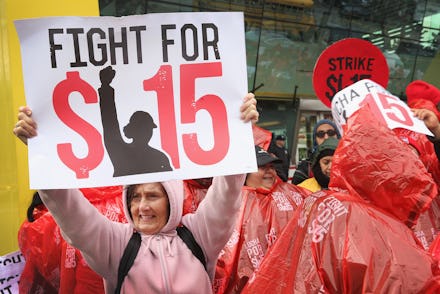2014 Was a Historic Year in the Fight for a Higher Minimum Wage

24 million.
That's the estimated number of Americans who would stand to benefit from raising the minimum wage from $7.25 to $10.10 an hour.
And this year there were many signs that those who struggle the most have reason for optimism: 2014 has seen an explosion in activity around raising the minimum wage.
From worker-led strikes to the White House, raising the minimum wage has become a hot national issue. While hiking the minimum wage isn't a policy issue that typically polarizes the public, it hasn't seen this kind of widespread attention for well over a decade.
Just as noteworthy as the surge in enthusiasm for a higher wage is the extent of the reformers' ambition. Most campaigns for a $15-an-hour wage have gone from a quixotic quest to reality in multiple cities, and the Fight for $15 workers' movement has gained unprecedented momentum.
"The federal minimum wage today is worth 25 percent less than it was back in 1968, even though minimum wage workers are far more educated and productive than they were decades ago," Amy Traub, senior policy analyst at the think tank Demos, told Mic. "It's not enough to live on, and it's not enough to support a family on, so it's no surprise that workers and their allies are organizing and calling for a raise."
Here are the highlights for this year's minimum- and low-wage battles:
Seattle and San Francisco passed a $15 minimum wage, and Chicago passed a $13 wage.
In 2014 Seattle and San Francisco passed the highest minimum wage laws in the nation.
Seattle's City Council unanimously passed a $15 minimum wage this summer. Council member Kshama Sawant, the city's first socialist to win citywide office since the early 20th century, is credited with forcing the wage hike onto the city's agenda during her campaign for office. The policy will be phased in over time, applying to many large businesses by 2017 and then to all businesses by 2021.
With a ballot measure during the midterm elections in November, voters in San Francisco approved of a $15 minimum wage in overwhelming numbers. The proposition phases in the increase over a three-year period, and should be fully in effect by the summer of 2018.
In December, Chicago's city council approved of the mayor's plan to boost the minimum wage to $13 per hour. The plan will be phased in beginning next year and will take full effect by 2019.
Four red states passed minimum wage hikes.
In the midterm elections, voters in four Republican-dominated states (Arkansas, Nebraska, Alaska and South Dakota) approved ballot measures increasing the minimum wage. In all but South Dakota, the propositions commanded over 60% of the votes. Observers expect even more of these kinds of measures to pass in 2016.
President Obama pushed for a higher federal minimum wage.
During this year's State of the Union address, Obama called for the federal minimum wage to be raised from $7.25 to $10.10, and announced an executive order implementing the raise for the 2 million federal contractors making the minimum wage. (Federal contractors then struck with the demand for more than $10.10 per hour.)
A change to the wage for all workers would have to pass through Congress, and Obama has encouraged them to take up such legislation on multiple occasions in the past year. The federal minimum wage hasn't been raised in over five years.
Fast-food workers organized the biggest strike in industry history.
In December, thousands of fast-food workers in nearly 200 cities walked off the job and demanded a $15 wage and union rights. The strike, part of the Fight for 15 campaign, was the largest strike in the history of the fast-food industry. It was backed by the Service Employees International Union, one of the most powerful labor unions in the United States, and garnered support from airport workers and local community activists. The first major mobilization of fast-food workers transpired in New York in 2012, and their ranks have swelled steadily since then.
Wal-Mart continued to face pressure over low wages.
Black Friday, the day after Thanksgiving on which major retailers offer special deals on goods, has become an increasingly politicized day over recent years, in no small part because of coordinated protests by retail workers over low pay, poor schedules and corporate anti-union practices. This year, Wal-Mart stores throughout the country were hounded by thousands of dissatisfied employees and supporters. It was the third year of Black Friday protests coordinated by OUR Walmart, a coalition of employees that are backed by major unions. Pressure from worker protests is likely related to the company adopting polices that allow workers to request more shifts for steadier work and improved pregnancy allowances.
The takeaway: In the absence of strongly unionized workforce, advances on low wages are being made by a variety of networks and institutions. Workers who are denied the ability to unionize are using union-backed daylong strikes and protests to draw popular attention to the exploitative tendencies of their employers, and they're building the case for more dignity in the workplace through a long-term campaign against their employers' reputation.
Major city governments are taking steps to mitigate the exorbitant cost of living and subsequent displacement of the working class in their cities. And the Democrats appear increasingly inclined to champion higher wages as they approach 2016. There's a lot of work to be done, but what's been done so far seems to be paying off.
This post has been updated.